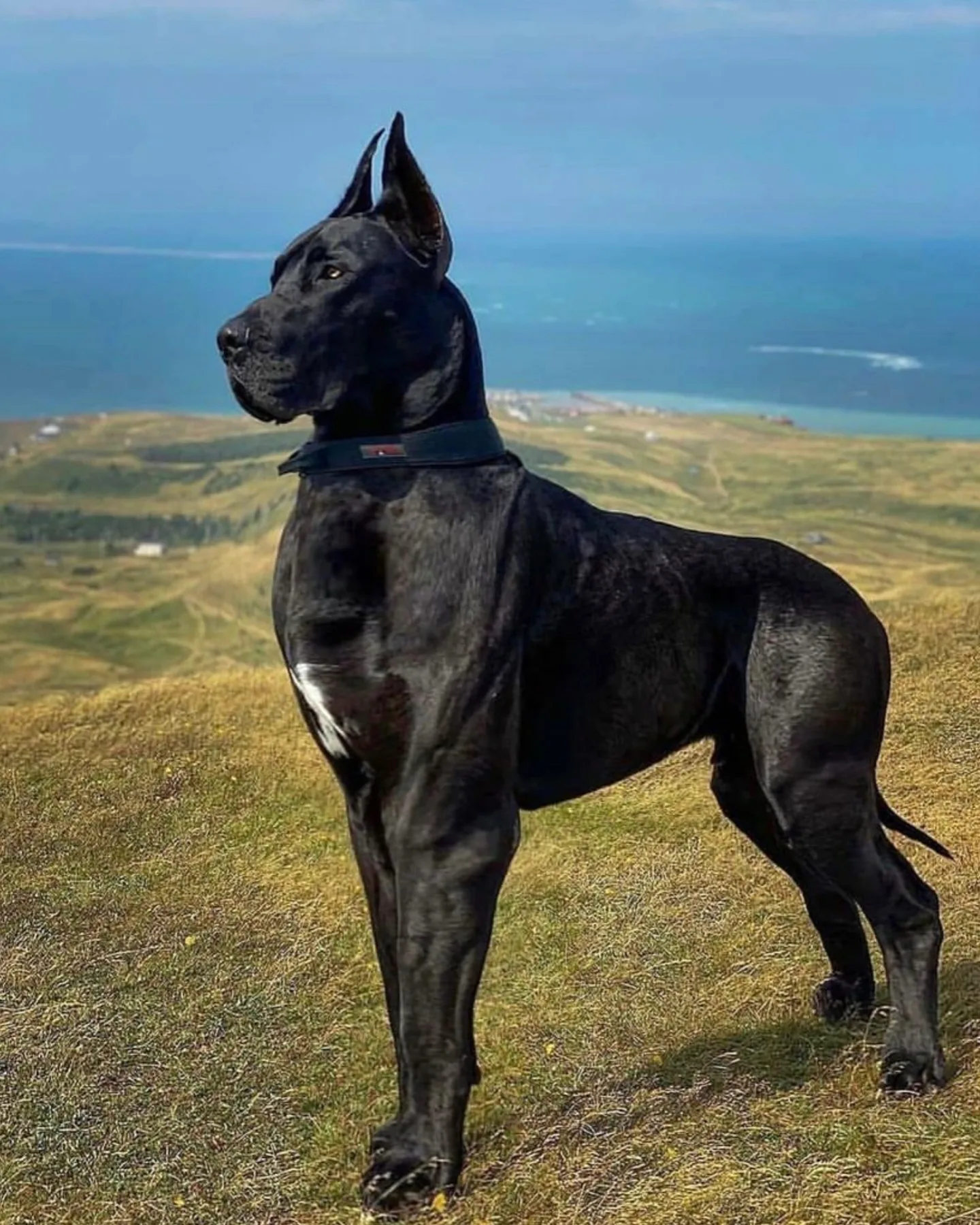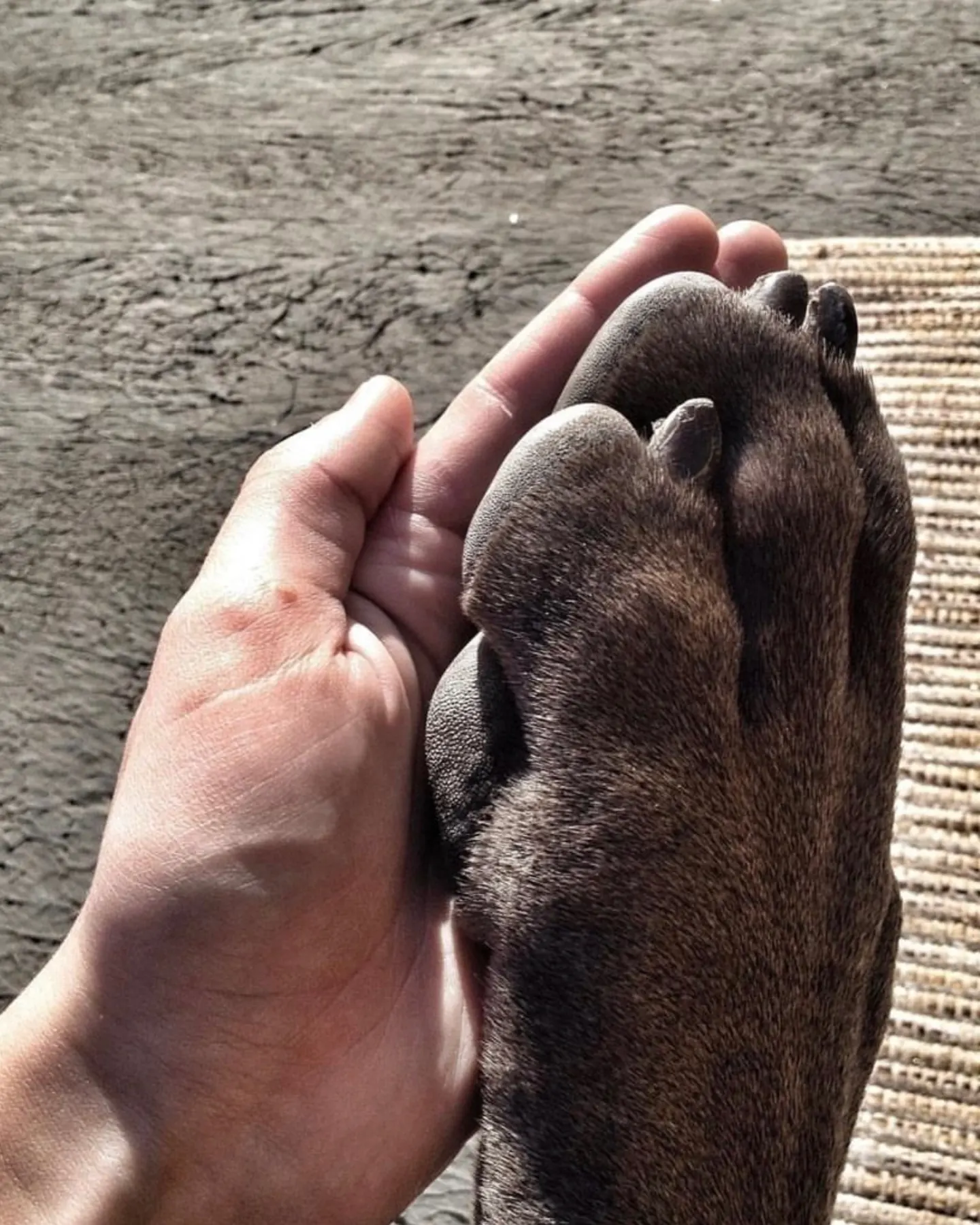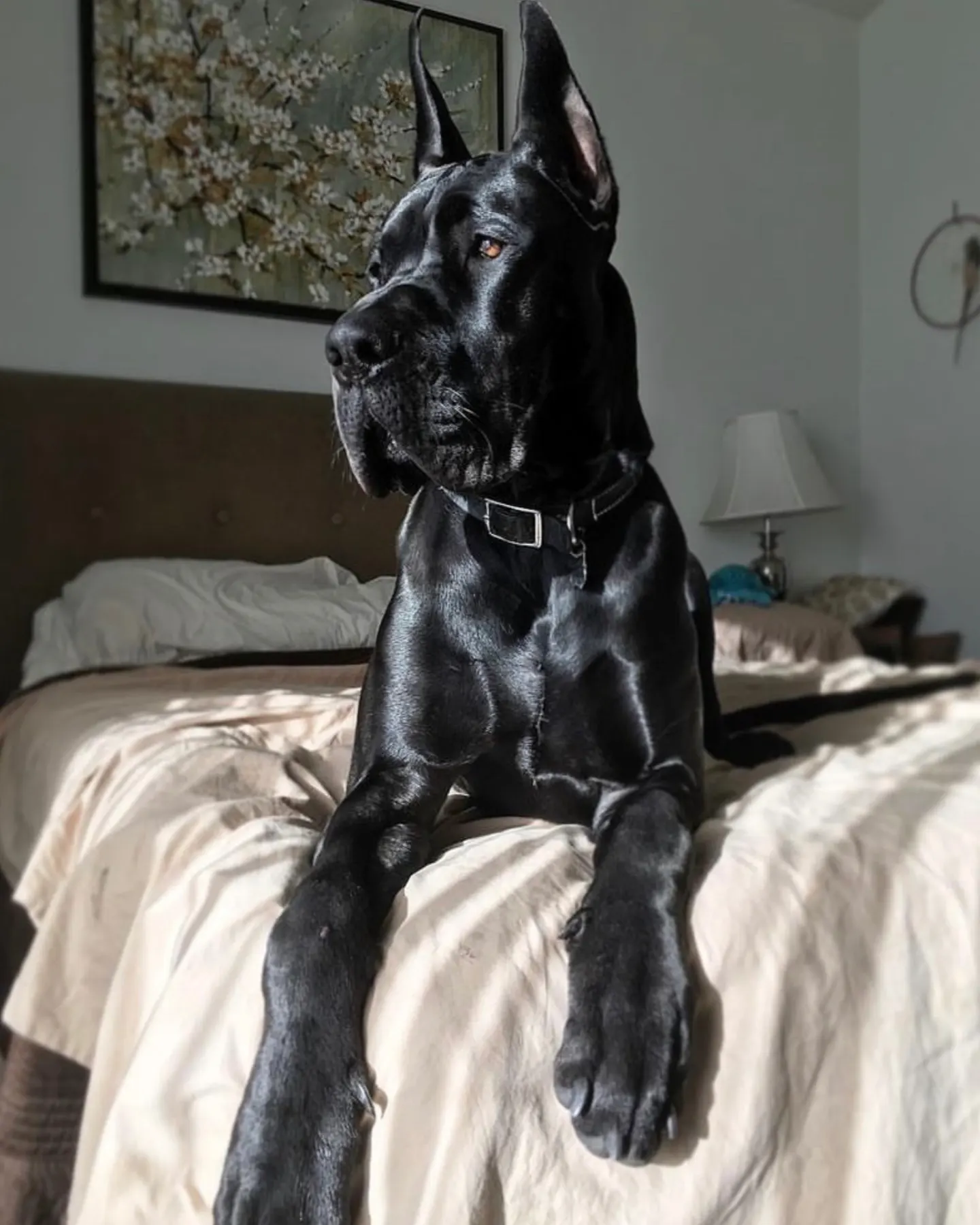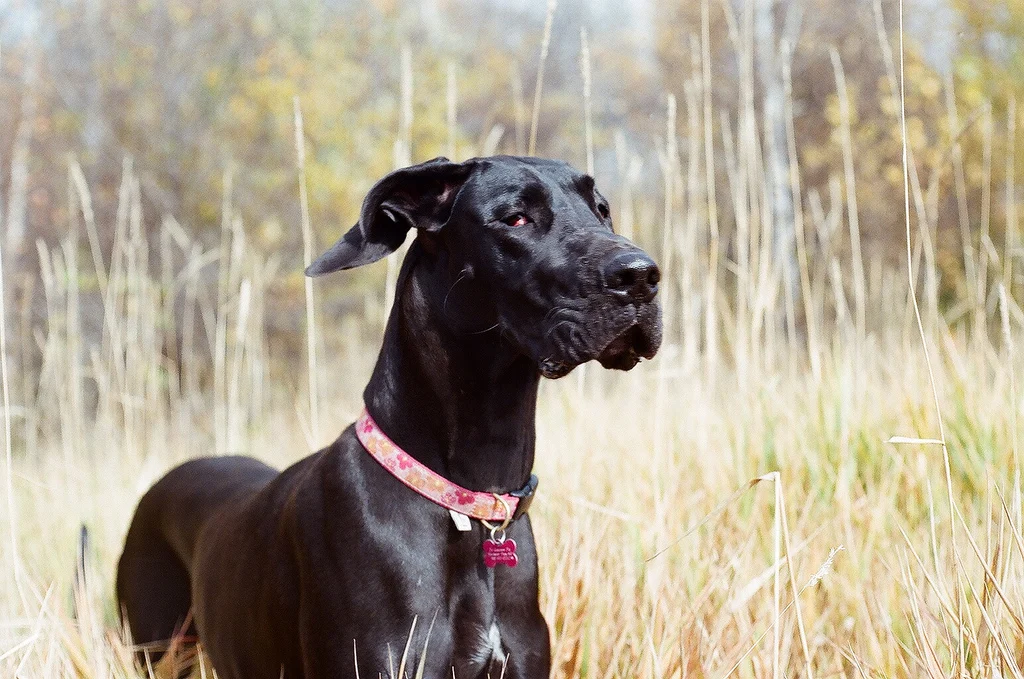Great Danes are in fact great. It’s no secret that these beautiful dogs are absolutely enormous. However, one thing that is bigger than their bodies is their heart. They are a true representation of gentle giants, and if you want a large dog with a sweet personality, then this could be the ideal breed for you. They are loyal, calm, and affectionate. Black Great Danes are even more gorgeous, which makes it clear why so many people choose this color variation. However, did you ever stop and wonder: How big do black Great Danes get?
In this article, we will go over the growth chart of a Great Dane. But that’s not all. We will also try to explain what it is that has an effect on the growth of these enormous animals. We will also go over other basic information that any future owner needs to be aware of, like their lifespan and possible health issues. So if you were in the market for getting a black Great Dane, then this article is just perfect for you.

Source: Instagram (@greatdanesentuidis)
How big do black Great Danes get?
Pretty big. So basically like any other Great Dane would be. Great Danes are actually known for being the biggest dog breed. When standing erect, they have a height of around 44 inches to the top of their head and about 32 inches from shoulder to shoulder. Additionally, they are about 48 inches long and up to 175 pounds heavy.
Great Danes have rapid development spurts, which usually happen between the ages of four and six months. Great Danes develop as much in a year as a human will in their first 14 years, according to the Great Dane Club of America!
The age at which Great Danes are regarded as fully grown is between 18 and 24 months. The majority of Great Danes attain their full height by 18 months of age, and during their second year they continue to gain muscle.
How big should a Great Dane be at six months old?
At six months old, the majority of Great Danes weigh between 65 and 100 pounds and are between 26 and 33 inches tall. Keeping in mind that each puppy is unique and will grow at a slightly different rate, keep in mind that these numbers represent averages.
You must keep an eye on the development of your Great Dane puppy. A Great Dane puppy’s risk of developing hip dysplasia and other joint issues increases with rapid growth. To slow down their rate of growth, feed your Great Dane puppy food designed for large breeds. Eating a large-breed growth dog food only lessens the overall stress on a Great Dane puppy’s body as it develops, without changing its final size.
How can I know if my Great Dane become any bigger?
Although they require at least two years to fully develop, Great Danes normally attain their adult height by the time they are 18 months old. Your Great Dane puppy is probably still gaining muscle to attain their full adult size if they are younger than two years old.
If you got your Great Dane from a breeder, get in touch with them for a more accurate height and weight estimate based on the parents and past litters of your Great Dane. Given that Great Dane puppies rarely grow larger than their parents, your breeder should be able to provide you with a more accurate estimation of your pet’s final size.
As an alternative, consider your Great Dane’s paws in relation to their legs and body. Do your Great Dane’s paws appear to be too big? This is a characteristic of puppies that shows they are still developing.
What affects the growth of a Great Dane?
The development of your Great Dane depends on a variety of factors. Your dog’s growth and potential influences can be better understood if you are aware of each one. In the event that the growth milestones are not what you anticipated, this might also give you comfort.
Growth peaks and valleys can occur at any point during your dog’s development. This either accelerates or retards the growth process. Since they happen at random, you can’t precisely rely on them to happen when you want them to. Simply remember that your dog is developing at his own rate. Giving your dog your all will enable them to develop to their greatest genetic potential. It’s recommended to consult a veterinarian to determine whether your puppy is growing normally if you are concerned about any changes in his or her growth.
Genetics
Even though size is a trait inherited from their ancestors, some dogs might be bigger or smaller than others. While this is merely an estimation and can be considerably off the mark, looking at the parents can typically give you an idea of how big your dog grows. A vast genetic puzzle, of which the parents are only a little piece. They might be genetically predisposed to have smaller, average, or larger kids. You won’t be able to tell for sure until your dog is fully mature. You can certainly compare notes by asking your breeder about other puppies their dogs have produced if that is what you choose.
Nutrition
The cornerstone for maintaining health is nutrition. This has a significant bearing on whether your dog grows to be large or small. Depending on his height, age, and degree of energy, your Dane will eat differently. This does not imply that overfeeding your dog will ensure he gains the most healthy weight possible.
This breed will eat as much as you feed him, thus it’s crucial not to overfeed him. He doesn’t require any additional weight to be put to his frame because they currently carry enough weight. Additionally, it may cause additional health issues and put additional strain on his heart system. This opens the door for fat and might possibly result in other orthopedic conditions.
The most crucial factor in his nutrition is feeding him premium kibble that offers him a diet that is well-balanced. This is particularly true for gigantic breed puppies, who require a denser nutritional mix to maintain their rapid growth. High-quality meats, fiber, carbs, good omega fats, vitamins, and minerals should all be included in a diet that is well-balanced.

Source: Instagram (@greatdane_igtiso)
Spaying and Neutering
Early spaying or neutering has little to no effect on a dog’s ability to grow. Their joints, however, might be compromised. According to several research, early neutering or spaying has an impact on your dog’s development plate. This postpones its closure and could cause your dog to get taller than usual. They may later get joint problems as a result of this. The ideal time to spay or neuter your dog should be discussed with your veterinarian. They can successfully develop and complete their version of puberty in this way.
Activity
Puppies with stunted growth may have been sick for a long period. You should regularly visit your veterinarian to make sure your puppy is as healthy as possible because a sick body cannot function to its fullest capacity. Injury can also affect how big a Great Dane grows. As they are developing, do not let them push themselves excessively. Always leave enough of space for your dog to play in order to prevent accidents where they could damage themselves.
Black Great Dane FAQ
What is the best color of Great Dane?
This is absolutely subjective and up to personal preference. There are seven accepted breed colors, and any of them has some perks. Choose whatever you like best, however, that shouldn’t be the most important thing when getting a dog. Instead, choose a puppy that you get along with the best, and that matches your vibe perfectly. There is no superior color, however, we would suggest to stay away from breeders who advertise their puppies as being rare or exotic. This can be a huge red flag, and there is a high chance that you will end up with a sick puppy.
Is a Great Dane a good family pets?
Great Danes make excellent household pets. They have good manners, sweet personalities, and are great around children. They are the largest lap dog on earth, and love to spend some quality time with their family members. These dogs are incredibly easy going, calm, and down to cuddle. Don’t let their size intimidate you, because chances are that you never owned a dog as lovable as a Great Dane is. That is not our way of shading other dog breeds, but Great Danes truly are a one of a kind breed.

Are solid black Great Danes rare?
Solid black Great Danes are incredibly rare. The Great Dane dog breed is most commonly found in fawn. And while the Great Dane breed standard does include black as an accepted color, it’s pretty hard to come across. The six other colors that the American Kennel Club accepts include blue, brindle, fawn, harlequin, mantle, and merle. Black Danes look especially elegant, and it’s no wonder that they were a favorite of German nobility.
What is the rarest Great Dane color?
The rarest Great Dane color is white. And as you can tell by what we have said above, white isn’t accepted by the American Kennel Club. Honestly, we would discourage anyone from buying a white Great Dane. Youu have a variety of colors to choose from, but white is just too much of a risk. White fur is associated with diseases such as Addison’s disease, bloat-gastric torsion, hip dysplasia, hypothyroidism, cardiomyopathy, Wobblers syndrome.
What dog breed is Scooby Doo?
The only possible answer to this is that Scooby Doo is a Great Dane. He just captures the Great Dane energy so perfectly. Even though this is the largest dog breed, they are still known to be goofy, clumsy, and a bit cowardly. They are true gentle giants after all. While we can’t say that with certainty, many fans of the breed and the show believe that Scooby was a Dane with cropped ears. Ear cropping is thankfully forbidden by now in the United States. However, there are still some countries in which ear cropping is practiced.
How much is a black Great Dane?
This is pretty hard to tell! As we have already explained, the black Dane is a pretty rare German Mastiff color. So it’s no surprise that some breeders decide to charge extra. That’s why you can expect prices to range from $1,500 to $2,500. If you want to find a good and reputable breeder, make sure you check out the Great Dane Club of America Breeders. They have a list of reputable breeders that check the former hunting dogs for medical conditions such as hip dysplasia or other diseases associated with their large size.

